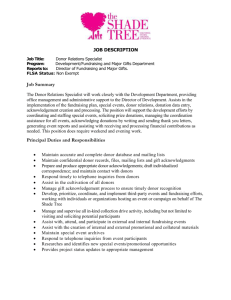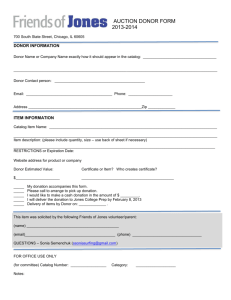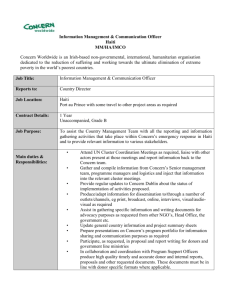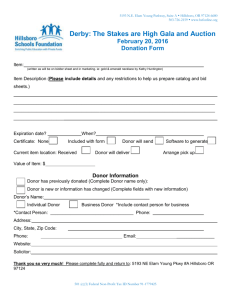SNBTS - LBC - Blood Donor Sessions
advertisement
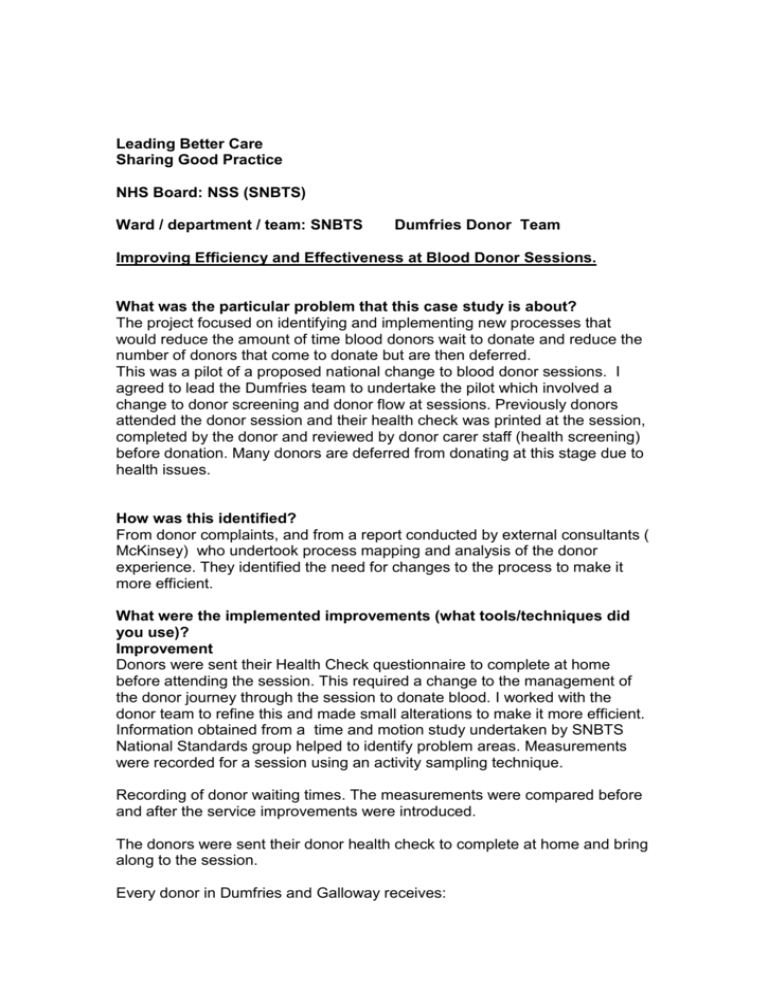
Leading Better Care Sharing Good Practice NHS Board: NSS (SNBTS) Ward / department / team: SNBTS Dumfries Donor Team Improving Efficiency and Effectiveness at Blood Donor Sessions. What was the particular problem that this case study is about? The project focused on identifying and implementing new processes that would reduce the amount of time blood donors wait to donate and reduce the number of donors that come to donate but are then deferred. This was a pilot of a proposed national change to blood donor sessions. I agreed to lead the Dumfries team to undertake the pilot which involved a change to donor screening and donor flow at sessions. Previously donors attended the donor session and their health check was printed at the session, completed by the donor and reviewed by donor carer staff (health screening) before donation. Many donors are deferred from donating at this stage due to health issues. How was this identified? From donor complaints, and from a report conducted by external consultants ( McKinsey) who undertook process mapping and analysis of the donor experience. They identified the need for changes to the process to make it more efficient. What were the implemented improvements (what tools/techniques did you use)? Improvement Donors were sent their Health Check questionnaire to complete at home before attending the session. This required a change to the management of the donor journey through the session to donate blood. I worked with the donor team to refine this and made small alterations to make it more efficient. Information obtained from a time and motion study undertaken by SNBTS National Standards group helped to identify problem areas. Measurements were recorded for a session using an activity sampling technique. Recording of donor waiting times. The measurements were compared before and after the service improvements were introduced. The donors were sent their donor health check to complete at home and bring along to the session. Every donor in Dumfries and Galloway receives: Letter about Home Health Check Pilot Donor information leaflet Leaflet on how to complete the Health Check Home Health Check Questionnaire (appx. 10 days before blood donor session) Review of “Call Up” system, I had to give feedback to the national group on improvements to the system, This was gathered from feedback forms from staff and donors affected by the changes and through discussion with the donor teams. What is the situation now? There has been a successful National ( SNBTS) implementation following a long trial of the pilot for SNBTS in the Dumfries and Galloway region. The process is constantly under review and there is continued feedback to both staff and from donors on changes implemented. (Plan Do Study Act) . How is the change sustainable? Financially beneficial with savings outweighing the cost of this change. The new processes are reviewed regularly with a view to make further improvements as required. Staff feedback forms are available to all staff involved and are regularly collected and reviewed. Measurable outcomes What are the patient ( donor) benefits? Reduction in the waiting time from initial processing of donors, A reduction in the amount of on session deferrals by 4% saving the donors time wasting visits and increasing productivity of session. Additional benefits may be increased accuracy in donor responses on the questionnaire ( due to completion at home) thereby increased safety for patients. What are the staff benefits? Increased productivity and reduction in the amount of donor complaints What are the organisational benefits? Financially benefits due to increase in productivity. Regular feedback to a National Group within the organisation has been conducive to the National Rollout of this Service Improvement. . How did staff feel before the improvement/during the improvement and after the improvement? The staff recognised there was room for improvement in parts of the of donation process and were suggestive of proposed changes to improve service. The number of staff involved was a small cohort of approximately 40 staff members. All fully informed in pre planning as well as regular meetings with middle management, forms were provided for both staff and donor feedback. Furthermore, staff feedback meetings were held regularly What are the lessons learnt and what would you do differently next time? Close communication with staff is beneficial to the initial response to major change within a process, also regular feedback from emerging issues with a system for reviewing solutions quickly. Realistic timelines for project parts that involve multi disciplinary teams What plans are there to spread the improvement? SNBTS national rollout of Home DSR and proposed changes to streamline other aspects of session processes are already planned and partly implemented with similar benefits recognised. I have delivered much of the training to the rest of the donor teams in Scotland and assisted with the implementation of the changes. . Contact information for case study Anne McIlduff, Team Manager, SNBTS 8 Nelson Mandela Square, The Athenaeum Glasgow



